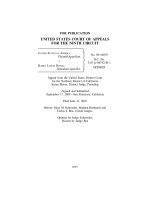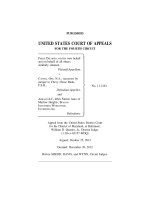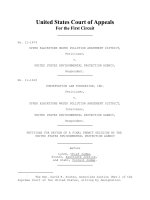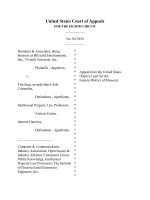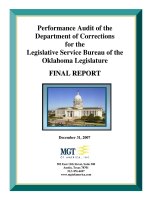Performance assessment of center for foreign language (CFL) A basic for the CFL development program
Bạn đang xem bản rút gọn của tài liệu. Xem và tải ngay bản đầy đủ của tài liệu tại đây (2.79 MB, 179 trang )
PERFORMANCE ASSESSMENT OF CENTER FOR FOREIGN
LANGUAGES (CFL): A BASIS FOR THE CFL
DEVELOPMENT PROGRAM
___________________________
A DISSERTATION
Presented to the Faculty of the Graduate School
Southern Luzon State University, Lucban, Quezon, Philippines
in Collaboration with
Thai Nguyen University, Socialist Republic of Vietnam
___________________________
In Partial Fulfillment
of the Requirements for the Degree
Doctor of Business Administration
___________________________
By
NGUYEN THI THUY TRANG (JOLIE)
December 2013
i
APPROVAL SHEET
The Dissertation of
NGUYEN THI THUY TRANG
entitled
PERFORMANCE ASSESSMENT OF CENTER FOR LANGUAGES (CFL):
A BASIS FOR THE CFL DEVELOPMENT PROGRAM
Submitted in Partial Fulfilment of the Requirements for the Degree
DOCTOR OF BUSINESS ADMINISTRATION
A program offered by Southern Luzon State University,
Republic of the Philippines in collaboration with
Thai Nguyen University, Socialist Republic of Vietnam
has been approved by Oral Examination Committee
MELCHOR MELO O. PLACINO, PhD
Expert
EDUARDO T. BAGTANG, DBM
Expert
EDWIN P. BERNAL, DBA
Expert
ALICE T. VALERIO, PhD
External Panel
CECILIA N. GASCON, PhD
Chairman
Endorsed by:
Recommended by:
WALBERTO A. MACARAAN, EdD
Adviser
APOLONIA A. ESPINOSA, PhD
Dean
Accepted in Partial Fulfilment of the Requirements for the Degree
Doctor of Business Administration
_____________________
Date
WALBERTO A. MACARAAN, EdD
Vice President for Academic Affairs
ii
CERTIFICATE OF ORIGINALITY
This is to certify that the research work / dissertation entitled
Performance Assessment of Center for Foreign Languages (CFL): A
Basis for the CFL Development Program, orally defended/ presented under
the DBA Program jointly offered by Southern Luzon State University of the
Republic of the Philippines and Thai Nguyen University of the Socialist
Republic of Vietnam, embodies the result of original and scholarly work
carried out by the undersigned.
This dissertation does not contain words or ideas taken from
published sources or written works by other persons which have been
accepted as basis for the award of any degree from other higher education
institutions, except where proper referencing and acknowledgment were
made.
NGUYEN THI THUY TRANG
Researcher/Candidate
Date Orally Defended: 09/12/2013
iii
ACKNOWLEDGMENT
The researcher would like to express her most sincere thanks to the
administrators and teachers of Southern Luzon State University and Thai
Nguyen University who have helped her facilitate her study.
Dr. Cecilia N. Gascon, Dr. Melchor Melo O. Placino, Dr. Alice T.
Valerio, Dr. E. Bagtang and Dr. Edwin P. Bernal, for providing her with a rich
and fertile environment to study and explore new ideas by providing useful
and memorable lectures;
Dr. Walberto A. Macaraan, her enthusiastic adviser who provided her
with valuable guidance, and encouragement to complete this dissertation;
Professor Tran Tuan Anh and Professor Nguyen Thanh Hai, lecturers
who managed the International Cooperation Program between Viet Nam and
Philippines, for spearheading the cooperation which gave her a chance to join
and fulfill the requirements of the course; and
Board of Academy of Finance (AOF), colleagues in AOF, classmates in
DBA1, especially Mr. Ngo Anh Cuong, who facilitated helped and shared
experiences to help her complete this dissertation.
NTTT
iv
DEDICATION
This dissertation is lovingly dedicated to my parents who have been my constant
source of inspiration who motivated me to tackle any task with enthusiasm
and determination. I also owe this to my supportive husband,
who always showered me with care, attention
and understanding and to my loving sons,
who inspired me to pursue my goal.
Without their love and support,
this dissertation would not
have been made possible.
NTTT
v
TABLE OF CONTENTS
PAGE
TITLE PAGE ………………………………………………………………..
i
APPROVAL SHEET ……………………………………………………….
ii
CERTIFICATE OF ORIGINALITY ………………………………………..
iii
ACKNOWLEDGEMENT …………………………………………………..
iv
DEDICATION ………………………………………………………………
v
TABLE OF CONTENTS …………………………………………………..
vi
LIST OF TABLES ………………………………………………………….
viii
LIST OF FIGURES ………………………………………………………...
x
LIST OF ABBREVIATIONS ……………………………………………….
xi
LIST OF APPENDICES …………………………………………………...
xii
ABSTRACT …………………………………………………………………
xiii
CHAPTER
I
II
III
INTRODUCTION ……………………………………………
1
Background of the Study …………………………………..
5
Objectives of the Study …………………………………….
6
Hypothesis of the Study ……………………………………
8
Significance of the Study …………………………………..
8
Scope and Limitation of the Study ………..………………
8
Definition of Terms ………………………………………….
9
REVIEW OF LITERATURE ……………………………….
13
Conceptual Framework ………………………………….…
57
METHODOLOGY
Locale of the Study …………………………………………
61
Research Design ……………………………………………
61
Populations, Sample Size & Sampling Technique ……...
62
Research Instrument ……………………………………….
67
Data Gathering Procedure ……………………….…….….
69
Statistical Treatment ………………………........…….……
69
vi
IV
V
RESULTS AND DISCUSSIONS ………………………….
71
Brief history of AOF and CFL ……………………………...
71
Overall performance ……………………………………….
72
Internal resources ……………………………………..……
73
Facilities …………………………………………………
73
Students ………………………………………………...
81
Faculty Benefits ………………………………………..
82
Training and Development ……………………………
84
Support Staff ……………………………………………
86
Performance of CFL ………………………………………..
90
Program Structure …………………………..…………
90
Faculty Performance ………………………………..…
93
Students’ Results ………………………………..……..
96
Administrative Support ………………………...………
97
Finance …………………………………………….……
99
Marketing ……………………………………….………
101
Performance Gap …………………………….………..
109
SUMMARYOF FINDINGS, CONCLUSIONS AND
RECOMMENDATIONS
Summary of Findings ………………………………………
111
Conclusions …………………………………………………
118
Recommendations..…………………………………...……
119
REFERENCES ………………………...…………………………………..
135
APPENDICES ……………………………………………………………...
137
CURRICULUM VITAE …………………………………………………….
162
vii
LIST OF TABLES
TABLE
PAGE
1
Number of Graduates in 2011-2016
34
2
Strategies by 2020
38
3
Course Offerings
39
4
Average Overall Grades of Graduates in 2007-2011
40
5
Employer’s Preferred Educational Institutions
43
6
Training and Development Programs for Teachers of
English in 2004-2011
46
7
Application of Initiatives Prior to School Year 2010-2011
47
8
Number of and Qualifications of Teachers of English
48
9
Annual Income of a 5-year Experienced Lecturer
48
10
Factors Affecting the Performance of CFL – AOF
63
11
Statistical Treatment Matrix
70
12
Teachers’ Evaluation of Online Exercises
75
13
Teachers’ Evaluation of Classtime Materials
75
14
Teachers’ Evaluation of Supplementary Materials
75
15
Learners’ Evaluation of Online Exercises
76
16
Teachers’ Evaluation of Classroom Facilities at CFL
76
17
Teachers’ Evaluation of Classroom Facilities at CFL
77
18
Teachers’ Evaluation of 25-seat Classrooms
77
19
Deadlines for 450 TOEIC Certificates
82
20
Frequency of Training Activities at AOF
84
21
Frequency of Training Activities at AOF
85
22
Frequency of Training Activities at CFL
85
viii
TABLE
PAGE
23
Strengths and Weaknesses of CFL’S Internal Resources
88
24
Gap Between CFL’S Internal Resources and Others
89
25
CFL Teachers’ Description on CFL Program Structure
90
26
TOEIC Preparation Programs
91
27
Profile of CFL Staff and Faculty
94
28
Teacher Working Shift
95
29
Frequency of Academic Meetings at CFL
96
30
Frequency of Group Discussion at CFL
96
31
CFL Income Statement
100
32
CFL in Comparison With Other Centers
102
33
Enrollments at CFL in 2012
103
34
Learners’ Preferences
103
35
Tuition Fees in Different Centers
105
36
Advertising and Online Activity Expenses in Other Centers
in 2012
106
37
Relation Between Learners’ Awareness and their Choice
107
38
Relation Between Learners’ Choice and Tuition Fees
108
39
Strengths and Weaknesses of CFL Performance
109
40
Gap Between CFL Performance and Other Centers
110
41
Time Frame of Objectives
117
42
Areas for Improvements
119
ix
LIST OF FIGURES
FIGURE
PAGE
1
Classification of Enterprises in Vietnam
21
2
Enrollments in 2011
35
3
Enrollments in 2010
36
4
Number of Applicants and Enrollments in 2010 and 2011
36
5
Annual Employability of Graduates (2004-2010)
37
6
Results of National Contests in 2004-2011
41
7
Employability of Graduates
42
8
Employability of Graduates
42
9
Conceptual Framework
60
10
Hiring Process at AOF
79
11
Hiring Process at CFL
80
12
Teachers’ Opinion on CFL Pay
83
13
Learners’ General Evaluation on Support Staff
97
14
Learners’ Evaluation on Staff’s Responses
98
15
Teachers’ General Evaluation on Support Staff
98
16
Teachers’ Evaluation on Staff’s Responses
99
17
Learners’ Sensitivity on Tuition Fees
104
18
Learners’ Awareness of CFL
106
x
LIST OF ABBREVIATIONS
AOF:
Academy of Finance
BA:
Banking Academy
CFL:
Center for Foreign Languages
FFL:
Faculty of Foreign Languages
HFT:
Foreign Trade University
HNEU:
Hanoi National Economics University
UOC:
University of Commerce
xi
LIST OF APPENDICES
APPENDIX
PAGE
A
Questionnaires
138
B
Additional Tables and Exhibits
154
B.1
Population Growth Rate in 1990 – 2010
154
B.2
Gross Domestic Product at Constant 1994 Prices by
Economic Sector
155
Gross Domestic Product at Current Prices by Economic
Sector
157
Retail Sales of Goods and Services at Current Prices by
Kind of Economic Activity
158
Structure of Employed Population at 15 years of Age and
Above as of Annual 1 July by Kinds of Economic Activity
159
B.6
Balance Sheet Comparisons
161
B.7
Income Statement Comparisons
161
B.3
B.4
B.5
`
xii
ABSTRACT
Title of Research
: PERFORMANCE ASSESSMENT OF CENTER
FOR FOREIGN LANGUAGES (CFL): A BASIS
FOR THE CFL DEVELOPMENT PROGRAM
Researcher
: NGUYEN THI THUY TRANG (JOLIE)
Degree Conferred
: DOCTOR OF BUSINESS ADMINISTRATION
Name and Address
of Institution
: Southern Luzon State University, Lucban, Quezon,
Philippines and Thai Nguyen University, Socialist
Republic of Vietnam
Adviser
: Dr. Walberto A. Macaraan
Year Written
: 2013
______________________________________________________________
Academy of Finance is one of very few nationally recognized stateowned universities in Vietnam and has provided the economy with highly
appreciated graduates in banking, finance and accounting. CFL was
established by the Director of Academy of Finance in 2010 with the aim of
providing AOF students with English proficiency skills to meet the market’s
needs. CFL focuses on English, while other OST programs are topic-specific
and focus on categories like the arts, sports, theatre, math or science. It is a
non- profit organization under the direct control of Academy of Finance and it
is different from other commercial language centers in the market and also
from other college’s/university’s centers that are directly controlled by the
Faculty of Foreign Languages of the college/university. The study addressed
the following: describe the internal resources of CFL in terms of facilities,
students, faculty benefits, training and support staff; assess the performance
of CFL in terms of program structure, faculty performance, student’s results,
administrative support, finance and marketing; to determine the performance
xiii
group of CFL; formulate a Center Development Program based on the
performance assessments. The research instruments used were offline
questionnaires and check-list for interviews. In 2012, CFL – AOF has about
300 learners. The sample size of the survey was 171 respondents/learners.
CFL has 14 teachers of English and AOF has 52, 7 were chosen from the
former and 45 for the latter as respondents. Interviews were also conducted
among management, staff, teachers, and learners of AOF, CFL and of its
competitors as well as representatives from the job market/employers. It was
shown in the results that the Center now has a lot of difficulties on resources
such as incompetent administrative staff, teachers and insufficient facilities for
English learning and teaching; and inappropriate academic management.
Enrollment and academic management play the most important role in the
Center operations. These factors have direct impacts on the performance of
the center. They are also the main factor that increase the competitiveness
and prolong the operation of the Center. Administration and facilities also play
an important role in the performance of the Center. For 30 months, the Center
had a total revenue of 592 m VND, expenses of 691 m VND for operations
excluding 652 m VND for staff’s salaries (paid by AOF). In terms of English
test results, 100 out of 300 learners got 450 TOEIC or higher. Thus, the
number of learners who failed to meet the MOET requirement for graduation
is too extensive. In conclusion, the study suggests to improve the Center’s
performance by applying the proposed suggestions in increasing enrollments,
managing academic issues to improve teaching and learning quality and
prepare learners for graduation; to improve logistics activities through
increasing the efficiency of the staff to increase teaching and learning quality
xiv
and create a good reputation for the Center; and to encourage AOF to invest
more in facilities in learning and teaching English, and in in-house training.
xv
1
Chapter I
INTRODUCTION
Today, Vietnam is involved in the global integration, both vertically and
horizontally. This has led to the requirement of English proficiency from
employers toward job seekers. In this context, Vietnam’s public schools are
putting a lot of pressure on their students under increasing pressure to
improve academic performance. The inexorable drive to reach continuously
higher levels of student achievement was spurred by the Ministry of Education
and Training – MOET’s requirements in English proficiency. The current
economic recession has only exacerbated the stress on educators at all
levels, as they are expected to push students’ achievement scores higher
than ever before (while also closing achievement gaps between different subgroups of students), despite diminishing resources that have resulted in
staffing cuts, larger class sizes, and fewer support services for many of the
nation’s students.
The increased emphasis on student achievement, in general and
student’s English proficiency, as measured by large-scale, state-mandated
summative assessments, has resulted in school leaders and education
policymakers embracing the notion that teachers can no longer afford to work
in isolation if they seek to improve the performance of their students. This
trend is apparent in the current literature on professional development, where
one can find an abundance of articles and books extolling the virtues of
teacher learning teams, collaborative learning teams, communities of
continuous
inquiry,
professional
learning
communities,
and
other
2
configurations of collaborative work arrangements among teachers. In reality,
educational researchers and advocates for educational reform have been
writing about various forms of teacher collaboration as a means to improve
educational outcomes since the early 1990’s (Hord, 2004; Pounder, 1998). As
Saunders, Goldenberg, and Gallimore (2009) indicated, there is “an intuitively
appealing logic that underlies PLC [professional learning communities] and
learning team programs” (p. 1009). Yet, despite the significant body of
literature regarding the importance of teacher collaboration in the effort to
improve schools and the “intuitive logic” of such an approach, there is a
dearth of empirical research that ties collaborative processes to improved
teacher practice and improved student learning (Gallimore, Ermeling,
Saunders, & Goldenberg, 2009; Goddard, Goddard, &Tschannen-Moran,
2007; InPraxis Group, Inc., 2006; Pounder, 1998; Saunders et al., 2009;
Vescio, Ross, & Adams, 2008). The following quote from InPraxis Group, Inc.
(2006) captures the current body of literature and contemporary wisdom
regarding the value of teacher collaboration and PLC-like approaches:
Although there is little empirical research that links collaborative
processes directly with student learning and achievement, there is a
relatively consistent recommendation emerging from the literature on
professional development – those who share the same concerns and
challenges will learn more effectively if they work together in a
professional development experience and teacher quality can be
positively affected. (p. 33)
The relative paucity of empirical research supporting the effectiveness
of professional learning communities (PLCs) poses the following question: In
3
schools that have implemented PLCs, to what extent have teacher practice
and student achievement improved? This is the key question driving the
establishment of out-of-school time programs, while schools have to follow
MOET’s rules of limited in-class time. Although a number of studies have
documented evidence regarding the various benefits of PLCs, for example,
enhanced teacher learning (Little, 2003; Grossman, Wineberg, & Woolworth,
2001), improved school culture (Supovitz, 2002), and changes in classroom
practice (Brownell, Adams, Sindelar, Waldron, &Vanhover, 2006), the most
valuable aspect of PLCs lies in their potential to impact student achievement
in a positive manner. As Brownell et al. (2006) argued, “Ultimately,
professional collaborative efforts are important only if they help teachers
change in ways that promote student learning” (p. 184).
Academy of Finance is one of very few nationally recognized stateowned universities in Vietnam and has provided the economy with highly
appreciated graduates in banking, finance and accounting. However, in recent
years, with higher requirement of English proficiency from employers,
Academy of Finance graduates have faced competition from other
universities’ graduates whose majors of banking, finance or accounting are
said to be less appreciated. The English proficiency requirement can be seen
in
many
job
advertisements
found
in
various
job
sites
such
as
Vietnamworks.com, vieclam.com, dulieuvieclam.com, timviecnhanh.com, etc.
According to Ministry of Education and Training, students can graduate from
university only when they reach a certain proficiency of English. Also, the
ministry requires each university to set its own requirement of English
4
proficiency. Accordingly, Academy of Finance requires 450 TOEIC for
graduation. This is compulsory for the 48th batch and other batches.
To better meet job requirements and to graduate from any course,
undergraduates prepare for it in one way or another. They are free to choose
an English center as long as they can obtain certain certificates such as
IELTS, TOEFL, TOEIC. Some universities provide their undergraduates with
their own choice of language centers and learners are free to choose an exam
for an international certificate or certificates issued by universities. Academy
of Finance could not increase the in-class time of English lessons, so out-ofschool time programs were recommended. In fact, Academy of Finance set
up its own language center in 2010 to serve firstly, its own students and then,
other interests. It is a kind of out of school time program for students.
Out of School Time (OST) is a general term that describes any
structured programs outside the normal school day hours. "The National
Institute on Out-of-School Time defines out-of-school time programs as
encompassing a wide range of program offerings for young people that take
place before school, after school, on weekends, and during the summer and
other school breaks " ("Making an Impact on Out-of-School Time: A Guide for
Corporation for National Service Programs Engaged in After-School, Summer,
and Weekend Activities for Young People," 2000, p. 3). The programs are
sometimes referred to as "after-school," "extended day," or "school-aged
care" programs and can occur before or after school or during the vacation
days. These terms are often used interchangeably.
5
CFL focuses on English while other OST programs are topic-specific
and focus on categories like the arts, sports, theatre, math or science.
While the definition of OST is quite broad, the OST programs reviewed
for this research study are those specifically created to meet the goals of
English proficiency. The specific program goal for CFL is, "To provide AOF
students with English proficiency." CFL has become a response to combat
the factors facing newly-graduated job seekers and to meet the academic and
social needs of students.
This school year, Academy of Finance is welcoming the 50th batch to
the campus. It means, there is only 2 years left for the 48th batch to get
themselves ready for graduation and the job market. As far as the researcher
observed, Center of Foreign Languages affiliated with Academy of Finance
has not achieved any success which is shown in the enrollment. As a teacher
of English in Academy of Finance as well as the Associate Dean of Faculty of
Foreign Languages, who is in charge of cooperating with Center of Foreign
Languages in serving Academy of Finance students, the researcher
personally think that a study on Center of Foreign Languages is in need to
find out a strategic plan for its development in order to implement its mission
and vision.
Background of the Study
Center of Foreign Languages was established by the Director of
Academy of Finance in 2010 with the aim of providing AOF students with
English proficiency skills to better meet the market’s needs. However, CFL
has served only few groups of about 300 students, far less than expected, out
6
of more than 10,000 currently enrolled students. This is a disappointing result.
Therefore, motivating students to engage in this program needs to be
addressed.
CFL is a not for profit organization under the direct control of Academy
of Finance. It is different from other commercial language centers in the
market and also differs from other college’s/university’s centers that are
directly controlled by Faculty of Foreign Languages of the college/university.
Studies or researches on commercial language centers in Vietnam,
especially in Hanoi have not been fully publicized though some researches on
market needs have been cited on newspapers and magazines. The
information from these researches can be used as secondary data for this
study. However, the special situation of CFL requires further research and
deeper analysis. Thus, this study was conducted to find ways to increase
CFL’s performance. It is aimed at how to increase the performance of CFL – a
provider of OST programs via a feasible strategic plan for CFL.
Objectives of the Study
The study aimed to assess the performance of CFL – Center of
Foreign Languages – affiliated with AOF – Academy of Finance, Hanoi,
Vietnam. It also wanted to examine teacher collaboration designed to
influence teachers’ classroom practice and student achievement outcomes in
AOF and CFL. The study is conceptually grounded on social capital theory
(Leana & Pil, 2006; Nahapiet & Ghoshal, 1998) and the construct of
development plan both of which will be presented in Chapter 2. In short, social
capital theory posits that the network of interpersonal relationships which exist
7
within any organization is a valuable resource that has the potential to
improve organizational performance (Nahapiet & Ghoshal, 1998). Social
capital theory is essentially interrelated with research-based descriptions of
collaboration practice; these organization-based groups are also viewed as
powerful units of analysis with the potential to improve overall organizational
and operational performance (Koliba & Gajda, 2009). This study explored the
relationship between the quality of collaboration within teacher-based teams
and student achievement outcomes as measured by mandated, annual
assessments. In addition, the study addressed the impact of administrative
leadership on the success of CFL by examining the relationship between
teachers’ perceptions of administrative support for discrete teacher teams
(PLCs) and student achievement outcomes, again measured by mandated,
annual state assessments. Also, the study assessed the performance of CFL
in terms of program structure, faculty performance, student’s results,
administrative support, finance and marketing and many other related issues
to come up with a feasible development plan for CFL. Specifically, it sought to
attain the following:
1. to describe the internal resources of CFL in terms of facilities,
students, faculty benefits, training and support staff;
2. to assess the performance of CFL in terms of program structure,
faculty performance, student’s results, administrative support,
finance and marketing;
3. to determine the performance group of CFL; and
4. to formulate a Center of Development Program based on the
performance assessment.
8
Significance of the Study
The study is very important for the existence of CFL as well as the
reputation of AOF. Ten years ago, AOF’s teachers of English majored in
Russian, not English. Over the last 10 years, only English-majoring applicants
have been recruited as teachers of English at AOF. However, it is still a
common knowledge that AOF graduates with low proficiency of English are
mainly due to non-English majoring teachers of English at AOF. It is also
believed to be the reason for low enrollment of AOF students.
The study of Strategic Plan for CFL would bring benefits to AOF for
CFL’s success would change the society’s perception on AOF’s students and
teachers of English. Faculty of Foreign Languages also will be benefited from
CFL’s success in this sense. Each individual teacher would get more offers
from external markets. After all, AOF graduates would be the first and most
important beneficiary because they have a good in-campus center for their
English learning. Personally, the researcher will be benefited too, because as
a leader, he/she needs to bring good changes to his/her students and
teachers.
Scope and Limitation of the Study
The study mainly focused on CFL’s current situation, target market and
successful examples in the sector. Besides, it is also about feasibility of some
options to come up with a recommendation for CFL.
The study studied AOF since 2000 to present and CFL from its
establishment in August 2010 to present. This was done through interviews
9
and surveys. The results of the study can be affected by a small number of
stakeholders in interviews and surveys.
Definition of Terms
For clarity and better understanding of this study, the following terms
were hereby defined conceptually and operationally:
Academic Curriculum or the academic program of study is the degree that
the student is working toward achieving, also referred to as "sought
learner outcome" (sought degree). Curriculum rules in the system
control the academic requirements defined in the approved program of
study (i.e., the student curriculum), represented by the program code in
Banner. Curriculum rules are also used in conjunction with program
codes to populate major, minor, concentrating, department, or other
related discrete pieces of data, to a variety of student record tables
(e.g., student level).
Academic Management means to coordinate the efforts of people to
accomplish goals and objectives using available resources efficiently
and effectively. Management comprises planning, organizing, staffing,
leading or directing, and controlling the center.
Additionally, fluency and language competence are
generally
recognized as being related, but separate controversial subjects. In
predominant frameworks in the United States, proficient speakers
demonstrate both accuracy and fluency, and use a variety of discourse
strategies. Thus, native speakers of a language can be fluent without
10
being considered proficient. This is also true for non-native English
speakers who are expected to be fluent and accurate at the same time.
Administration is the process or activity of running the center. The goal of
administration (more exactly administrative activities) is to ensure
smooth running of the center’s process by coordinating people
participating in the processes, and providing them with information
needed for completing their assignments. Administration deals with
gathering, processing and communicating information. Practically,
everybody working for an organization participates in the administrative
activities.
The
administration
is
regulated
by rules (operational
instructions, or procedures) that prescribe or recommend who should
be doing what and in what order in each type of the processes.
English Proficiency is the ability of an individual to speak or perform in an
acquired language, English. As theories among pedagogues as to what
constitutes proficiency go, there is little consistency as to how different
organizations classify it.
Enrollment is the act or process of enrolling students/ learners in the center.
Enrollment management can include: improving yields at inquiry,
application, and enrollment stages; increasing net revenue, usually by
improving the proportion of entering students capable of paying most or
all of unsubsidized tuition; ("full-pays"); increasing demographic
diversity; improving retention rates and increasing applicant pools
HR Management is the process of hiring and developing employees so that
they become more valuable to the center. Human Resources



